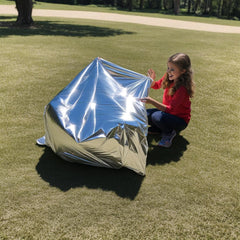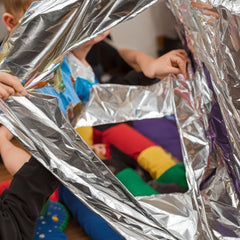A foil space blanket can be an excellent tool for sensory play, offering a wide range of sensory experiences for children and adults alike. Here are some creative ideas for using a foil space blanket in sensory play:
Tactile Exploration Ideas
The crinkly and metallic surface of the foil space blanket provides a different tactile sensation compared to typical fabrics. Here are some tactile activity ideas:

⦁ Feel the unique texture of the foil space blanket, crinkle the foil blanket with your hands, creating different sounds and sensations.
⦁ Create a tunnel using the foil blanket, allowing the child to crawl through and experience the tactile sensations of the foil.
⦁ Provide markers or paint for the child to create tactile art on the foil's surface.
⦁ Hide small objects within the folds of the foil blanket and have the child find them using their sense of touch.

⦁ Integrate the foil blanket into an obstacle course, allowing the child to crawl, roll, or walk on it as part of the sensory experience.
⦁ Lie down on the foil blanket and trace your body outline with your fingers, exploring self- awareness.
⦁ Combine storytelling with tactile exploration by using the foil blanket as a backdrop and incorporating texture-related elements into the narrative.
⦁ Provide a variety of textured objects and sort them onto the foil blanket based on their tactile qualities.
Sound Sensation Ideas
⦁ Encourage individuals to crinkle it, producing various sounds.
⦁ Hang the foil blanket as a barrier or curtain and tap or shake it from one side while others listen from the opposite side.
⦁ Attach small bells, chimes, or musical instruments to the foil blanket and encourage participants to move or shake it to create a musical performance.

⦁ Use the foil blanket as a backdrop while telling a story, and incorporate sound effects created by manipulating the foil at key moments in the narrative.
⦁ Integrate textured objects (sandpaper, fabric, paper, etc.) with the foil blanket and explore the sounds produced when you rub the materials together.
⦁ Play a game where you act out objects or animals silently using the foil blanket to create sound effects. Others guess what you are portraying based on the sounds.
⦁ Take the foil blanket outside when it’s raining to hear the sound of the raindrops falling on it.
⦁ Put the foil blanket in a water/tuff tray and drop some water on it, listening to the sound, you could change the amount of water that drops to compare sounds.
⦁ Take the foil blanket outdoors and explore the sounds of nature. Discuss how the foil amplifies or modifies these natural sounds.
⦁ Invite children to work together to create a unique sound composition using the foil blanket and other sound-making objects.
Visual Stimulation Ideas
The reflective surface of the space blanket can capture and reflect light in interesting ways.
⦁ Shine a torch or light up toy onto the space blanket to create visually stimulating effects. This can be especially captivating in a dark or dimly lit room.
⦁ Use the foil blanket as a makeshift mirror by allowing children/adults to see their reflection in it. This can be fascinating for babies and young children.

⦁ Provide markers or crayons and encourage participants to draw or colour on the foil blanket. The reflective surface adds an interesting dimension to their artwork.
⦁ Cut the foil blanket into pieces, and participants can reassemble them into a larger picture, enhancing fine motor skills and visual-spatial awareness.
⦁ Place textured objects (leaves, coins, fabric) under the foil blanket and use crayons or pencils to make rubbings of the textures.
⦁ Create shadows on the foil blanket. Experiment with different angles and shapes.
⦁ Cut the foil blanket into long strips and tape them together to form a cylindrical shape. Look through one end to see a kaleidoscope of reflections and colours.
⦁ Create a tent or fort using the foil blanket and add soft lighting inside to create a magical, reflective space.
⦁ Set up a shadow puppet theatre by projecting a light source onto the foil blanket and have children create and perform their shadow puppet shows.
⦁ Cut the foil blanket into small squares and use them to create a mosaic-style artwork. Discuss the patterns and designs that emerge.
⦁ Experiment with optical illusions by distorting or crinkling the foil blanket and observing how it affects the reflection of objects.
⦁ Take the foil blanket outdoors and use it to lie down and watch the sky. Observe the clouds, stars, and any passing birds or planes.
Group Play Ideas - Foil Space Blanket
Here are twelve ways in which you can engage in group activities using the space blanket.
1. Foil Blanket Volleyball: Divide the group into two teams and use the foil blanket as a makeshift net. Players hit a soft ball (e.g., beach ball or balloon) over the foil "net" to score points. The team that lets the ball touch the ground loses a point.
2. Parachute Games: Use the foil blanket as a parachute. Gather participants in a circle, hold the edges of the foil blanket, and lift it up and down. You can play games like "popcorn," where small objects are placed in the centre and children shake the foil to make them "pop" into the air.
3. Foil Blanket Limbo: Two participants hold the foil blanket horizontally while others take turns trying to limbo underneath it without touching the foil. Lower the blanket with each round to increase the challenge.
4. Blanket Statues: Children work in pairs or small groups. One person stands behind the foil blanket and shapes it to create a "statue" of an object, animal, or scene. The other person guesses what the statue represents.
5. Foil Blanket Musical Chairs: Arrange chairs in a circle with one fewer chair than there are children. Play music and have children walk around the chairs while holding the foil blanket. When the music stops, they must quickly sit on a chair and cover themselves with the foil. The one left standing without a chair is out.
6. Foil Blanket Hot Potato: Sit in a circle and pass a soft object (the "hot potato") around the foil blanket while music plays. When the music stops, the person holding the hot potato must perform a fun challenge or task.
7. Foil Blanket Tug of War: Divide the group into two teams and use the foil blanket as the "rope." Each team holds one end of the blanket and tries to pull the other team across a designated line.
8. Foil Blanket Synchronized Movement: In pairs or small groups, children use the foil blanket as a prop to create synchronized dance or movement routines. They can incorporate lifts, twists, and creative choreography.
9. Foil Blanket Art Collaboration: Lay the foil blanket on a flat surface and have participants collaborate to create a large artwork on it using various art supplies.
10. Foil Blanket Treasure Hunt: Hide small objects or clues under the foil blanket in a designated area. Teams or individuals must search for and retrieve the items without peeking.
11. Foil Blanket Shelter Building: Challenge groups to construct a shelter or fort using the foil blanket and other materials. See whose shelter can withstand the most "rain" (sprinkle with water).
12. Foil Blanket Theatre: Create impromptu skits or mini plays using the foil blanket as a backdrop or prop. Participants can take on different roles and act out scenes.
Always ensure safety during sensory play and supervise children, especially when using materials like the foil space blanket as it is NOT A TOY. Additionally, consider individual preferences and sensitivities when incorporating it into sensory activities. The versatility of a foil space blanket makes it a valuable addition to sensory play experiences.

